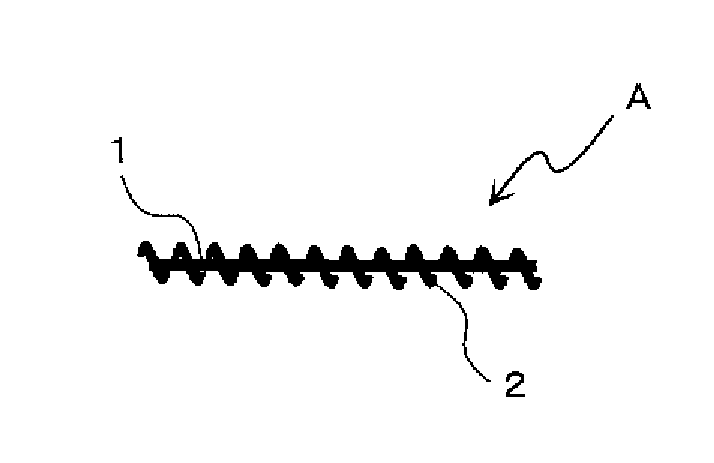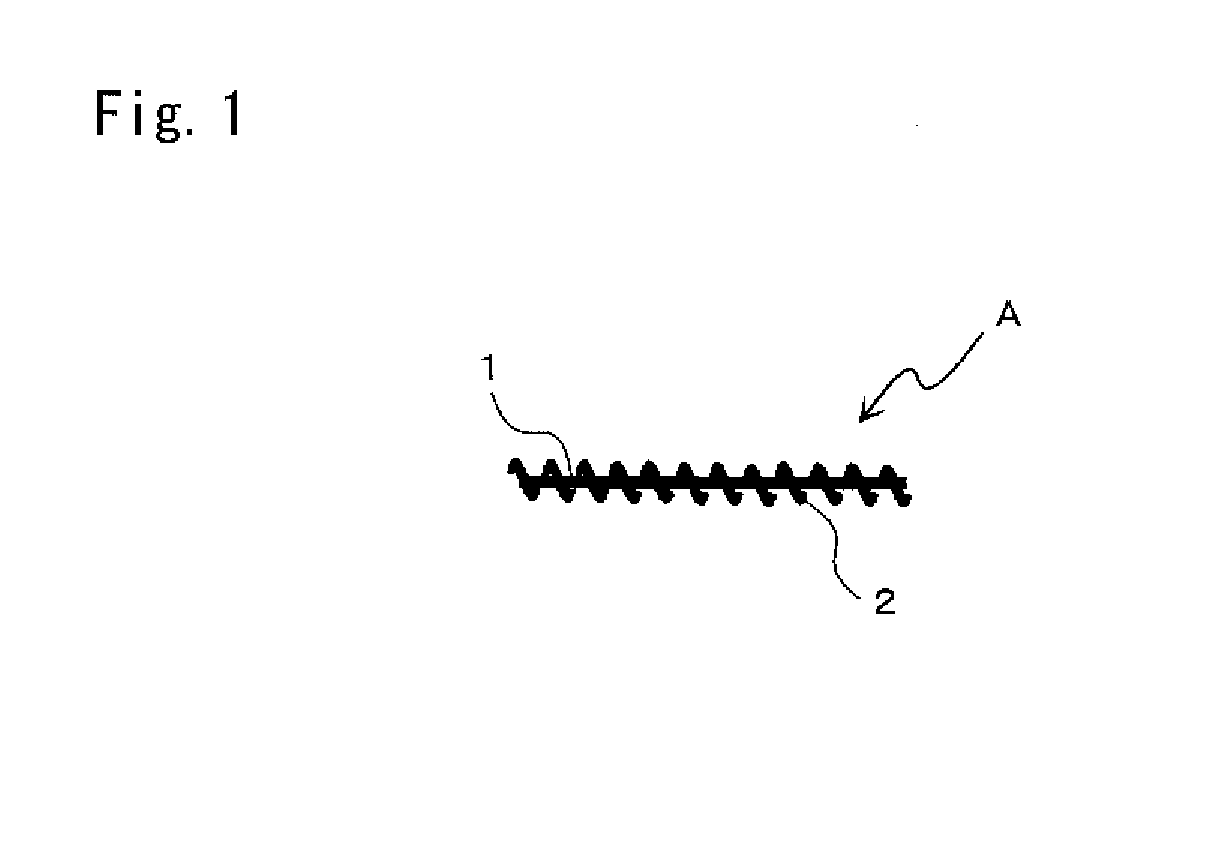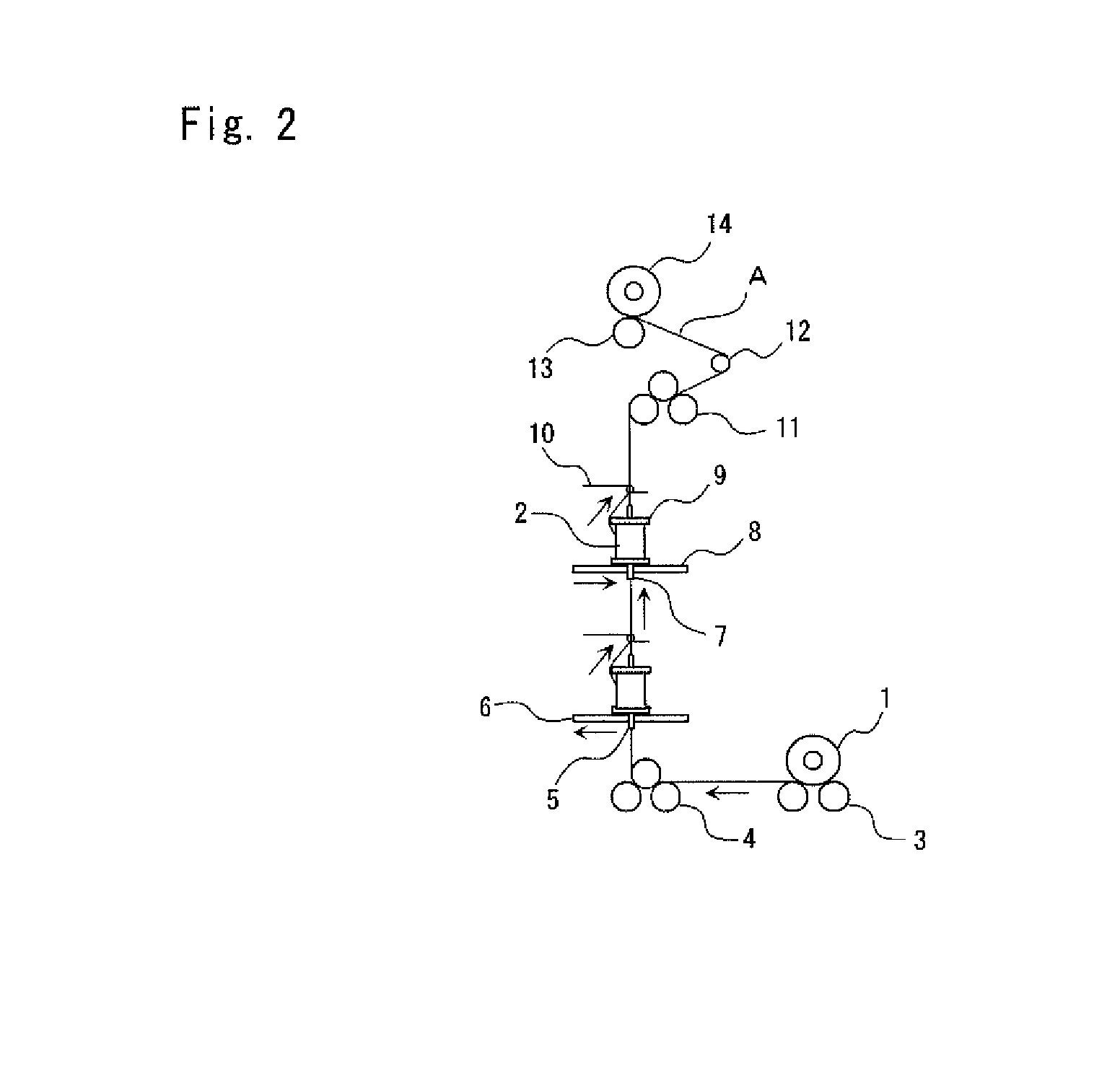Resin-coated glove
a technology of resin coating and glove, applied in the field of gloves, can solve the problems of high risk of being exposed to flames and high temperature, poor stretchiness of obtained clothing products, and general thermoplastic synthetic fibers are not considered suitable as protective fiber raw materials for clothing products used, etc., to achieve excellent adhesiveness, reduce cut wound resistance, and good workability
- Summary
- Abstract
- Description
- Claims
- Application Information
AI Technical Summary
Benefits of technology
Problems solved by technology
Method used
Image
Examples
example 1
[0102]Using a filament yarn of polyparaphenylene terephthalamide fiber (hereinafter referred to as PPTA) (manufactured by DuPont-Toray Co., Ltd., trade name “Kevlar,” registered trademark) having a total fineness of 440 dtex, a monofilament fineness of 1.7 dtex, a number of filaments of 267, a tensile strength of 2.03 N / tex, and a water content of 7%, continuous false twisting was carried out under the processing conditions of false twisting rate: 60 m / min, false twisting temperature (dry heat): 500° C., number t of false twists: 1,150 twists / m, false twist twisting direction: S direction, and number of spindle revolution: 69,000 rpm, thereby obtaining a crimped yarn (a twist factor (K1)=7,628) of PPTA filaments having a strength retention of 40%. The characteristic of the obtained crimped yarn are shown in Table 1.
[0103]Using the covering step shown in FIG. 2, as a bottom twist yarn of a sheath yarn, a nylon fiber wooly finished yarn (twist direction: Z twist) having a fineness of ...
example 2
[0111]A glove was fabricated in exactly the same manner as in Example 1, except that a PPTA filament yarn used had a total fineness of 440 dtex, a monofilament fineness of 3.3 dtex, a number of filaments of 134, a tensile strength of 2.03 N / tex, and a water content of 7%. The crimped yarn obtained at this time had a strength retention of 38%. The characteristics of the obtained crimped yarn are shown in Table 1.
[0112]The obtained glove had a weight of 18.5 g / piece and a weight at the palm area of 350 g / m2, and was soft, voluminously textured, very stretchy and fitted well, and had good bum resistance and heat resistance as well as knife-cutting resistance (cutting force: 8.4 N).
[0113]The glove coated with the urethane resin in the same manner as in Example 1 had a weight of 21.5 g / piece and an amount of the adhered resin on the palm area of 115 g / m2, was a back-uncoated glove with the coating material applied only to one side, with good adhesiveness of the coating material, and was ...
example 3
[0119]A crimped yarn of PPTA filaments was obtained by carrying out the continuous false twisting under the same processing conditions as in Example 1 using the same PPTA filament yarn as that used in Example 1 having a total fineness of 440 dtex, a monofilament fineness of 1.7 dtex, a number of filaments of 134, a tensile strength of 2.03 N / tex, and a water content of 7%, except that the false twisting temperature (dry heat) was 470° C. The characteristics of the obtained crimped yarn are shown in Table 1.
[0120]The obtained glove had a weight of 18 g / piece and a weight at the palm area of 356 g / m2, and was soft, voluminously textured, very stretchy and fitted well, and had good bum resistance and heat resistance as well as knife-cutting resistance (cutting force: 6.4 N).
[0121]Then, a back-uncoated glove with the coating material applied only to one side having a weight of 21.5 g / piece and an amount of the adhered resin on the palm area of 110 g / m2 was fabricated in the same manner ...
PUM
| Property | Measurement | Unit |
|---|---|---|
| shrinkage/elongation ratio | aaaaa | aaaaa |
| temperature | aaaaa | aaaaa |
| decomposition temperature | aaaaa | aaaaa |
Abstract
Description
Claims
Application Information
 Login to View More
Login to View More - R&D
- Intellectual Property
- Life Sciences
- Materials
- Tech Scout
- Unparalleled Data Quality
- Higher Quality Content
- 60% Fewer Hallucinations
Browse by: Latest US Patents, China's latest patents, Technical Efficacy Thesaurus, Application Domain, Technology Topic, Popular Technical Reports.
© 2025 PatSnap. All rights reserved.Legal|Privacy policy|Modern Slavery Act Transparency Statement|Sitemap|About US| Contact US: help@patsnap.com



